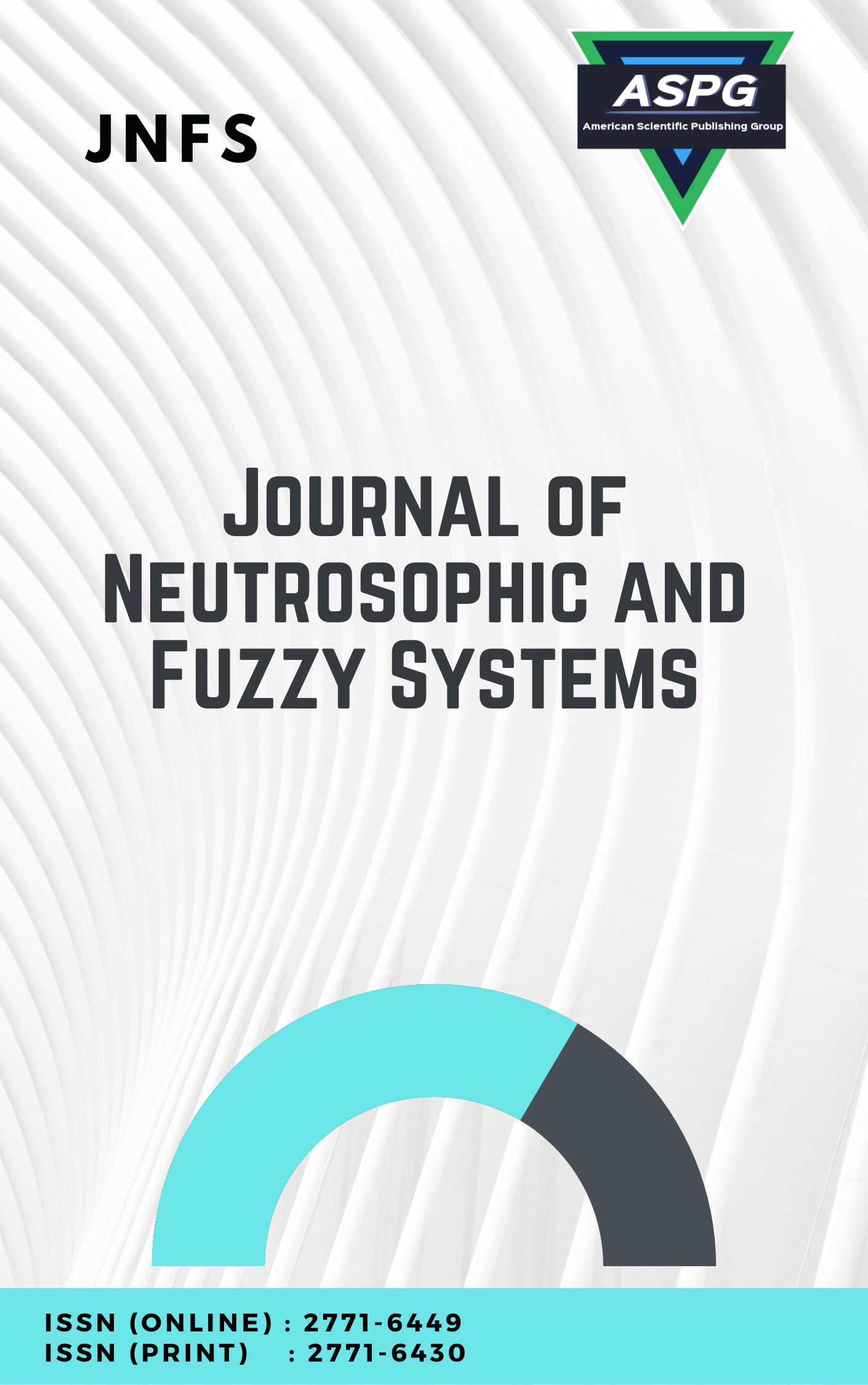

Volume 5 , Issue 2 , PP: 38-50, 2023 | Cite this article as | XML | Html | PDF | Full Length Article
Abdullah Ali Salamai 1 *
Doi: https://doi.org/10.54216/JNFS.050204
The terrible consequences that floods are having on human life and property can be seen all around the globe. The flood risks management problem is subject to uncertain and imprecise data, and it is influenced by several different factors. As a result, the assessment procedure in question might be seen as an instance of a challenging uncertain multi-criteria decision-making (MCDM) issue. Within the context of single-valued neutrosophic sets (SVNSs), this research aims to present a novel integrated methodology that is based on the Combined Compromise Solution (CoCoSo) technique under a neutrosophic environment. Both the decision-makers and the weights of the criteria are completely unknown. The average technique is used in the proposed methodology to calculate the weighting of the criteria, and an updated version of the CoCoSo method is used within the context of the SVN to decide which option is the most appropriate. In addition, an example case study of flood risk management is explored to highlight the entire execution process of the suggested technique. In addition, a comparison with other approaches that already exist is described to evaluate the validity of the results that were achieved.
Risk Management , Flood , MCDM , Neutrosophic , single-valued neutrosophic
[1] R. B. Mudashiru, N. Sabtu, I. Abustan, and W. Balogun, “Flood hazard mapping methods: A review,”
Journal of Hydrology, vol. 603, p. 126846, 2021.
[2] S. M. H. Shah, Z. Mustaffa, F. Y. Teo, M. A. H. Imam, K. W. Yusof, and E. H. H. Al-Qadami, “A review
of the flood hazard and risk management in the South Asian Region, particularly Pakistan,” Scientific
African, vol. 10, p. e00651, 2020.
[3] N. A. Bazai et al., “Increasing glacial lake outburst flood hazard in response to surge glaciers in the
Karakoram,” Earth-Science Reviews, vol. 212, p. 103432, 2021.
[4] P. D. Bates et al., “Combined modeling of US fluvial, pluvial, and coastal flood hazard under current and
future climates,” Water Resources Research, vol. 57, no. 2, p. e2020WR028673, 2021.
[5] M. S. G. Adnan, A. Y. M. Abdullah, A. Dewan, and J. W. Hall, “The effects of changing land use and
flood hazard on poverty in coastal Bangladesh,” Land Use Policy, vol. 99, p. 104868, 2020.
[6] S. Janizadeh et al., “Mapping the spatial and temporal variability of flood hazard affected by climate and
land-use changes in the future,” Journal of Environmental Management, vol. 298, p. 113551, 2021.
[7] K. Khosravi et al., “Convolutional neural network approach for spatial prediction of flood hazard at
national scale of Iran,” Journal of Hydrology, vol. 591, p. 125552, 2020.
[8] K. Uddin and M. A. Matin, “Potential flood hazard zonation and flood shelter suitability mapping for
disaster risk mitigation in Bangladesh using geospatial technology,” Progress in disaster science, vol. 11,
p. 100185, 2021.
[9] D. Ahmad and M. Afzal, “Flood hazards and factors influencing household flood perception and mitigation
strategies in Pakistan,” Environmental Science and Pollution Research, vol. 27, no. 13, pp. 15375–15387,
2020.
[10] H. Zhu and F. Liu, “A group-decision-making framework for evaluating urban flood resilience: a case
study in yangtze river,” Sustainability, vol. 13, no. 2, p. 665, 2021.
[11] H. Akay, “Flood hazards susceptibility mapping using statistical, fuzzy logic, and MCDM methods,” Soft
Computing, vol. 25, no. 14, pp. 9325–9346, 2021.
[12] A. Tella and A.-L. Balogun, “Ensemble fuzzy MCDM for spatial assessment of flood susceptibility in
Ibadan, Nigeria,” Natural Hazards, vol. 104, no. 3, pp. 2277–2306, 2020.
[13] J. S. Chai et al., “New similarity measures for single-valued neutrosophic sets with applications in pattern
recognition and medical diagnosis problems,” Complex & Intelligent Systems, vol. 7, no. 2, pp. 703–723,
2021.
[14] A. R. Mishra, P. Rani, and R. S. Prajapati, “Multi-criteria weighted aggregated sum product assessment
method for sustainable biomass crop selection problem using single-valued neutrosophic sets,” Applied
Soft Computing, vol. 113, p. 108038, 2021.
[15] S. Pramanik, “Single-Valued Neutrosophic Set: An Overview,” Transdisciplinarity, pp. 563–608, 2022.
[16] V. Başhan, H. Demirel, and M. Gul, “An FMEA-based TOPSIS approach under single valued
neutrosophic sets for maritime risk evaluation: the case of ship navigation safety,” Soft Computing, vol.
24, no. 24, pp. 18749–18764, 2020.
[17] S. Ashraf, S. Abdullah, F. Smarandache, and N. ul Amin, “Logarithmic hybrid aggregation operators based
on single valued neutrosophic sets and their applications in decision support systems,” Symmetry, vol. 11,
no. 3, p. 364, 2019.
[18] D. Karabašević et al., “A novel extension of the TOPSIS method adapted for the use of single-valued
neutrosophic sets and hamming distance for e-commerce development strategies selection,” Symmetry,
vol. 12, no. 8, p. 1263, 2020.
[19] M. Şahin and A. Kargın, “New similarity measure between single-valued neutrosophic sets and decisionmaking applications in professional proficiencies,” in Neutrosophic Sets in Decision Analysis and
Operations Research, IGI Global, 2020, pp. 129–149.
[20] Z. Turskis, R. Bausys, F. Smarandache, G. Kazakeviciute-Januskeviciene, and E. K. Zavadskas, “Mgeneralised q-neutrosophic extension of CoCoSo method.,” International Journal of Computers,
Communications & Control, vol. 17, no. 1, 2022.
[21] X. Peng and F. Smarandache, “A decision-making framework for China’s rare earth industry security
evaluation by neutrosophic soft CoCoSo method,” Journal of Intelligent & Fuzzy Systems, vol. 39, no. 5,
pp. 7571–7585, 2020.
[22] A. Petrovas, R. Baušys, E. K. Zavadskas, and F. Smarandache, “Generation of creative game scene patterns
by the neutrosophic genetic CoCoSo method,” Studies in informatics and control, vol. 31, no. 4, pp. 5–11,
2022.
[23] P. Rani and A. R. Mishra, “Novel single-valued neutrosophic combined compromise solution approach
for sustainable waste electrical and electronics equipment recycling partner selection,” IEEE Transactions
on Engineering Management, 2020.
[24] P. Rani, J. Ali, R. Krishankumar, A. R. Mishra, F. Cavallaro, and K. S. Ravichandran, “An integrated
single-valued neutrosophic combined compromise solution methodology for renewable energy resource
selection problem,” Energies, vol. 14, no. 15, p. 4594, 2021.